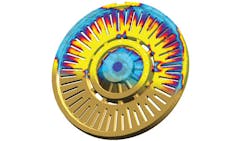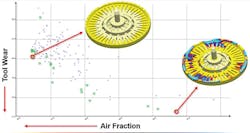The Next Level of Casting, Coremaking Process Simulation
Foundries have replaced time consuming and costly real-world trial and error procedures by using simulation for over 25 years. They have been using these tools to optimize casting designs and processes. Lately, new software tools for the simulation of sand coremaking and corebox designs, including several coremaking processes, have been added to the offerings simulation companies provide to the metalcasting industry. The combination of these new coremaking simulation tools with traditional casting process simulation software significantly improves casting quality and cost. MAGMA®, a leading provider of such simulation tools, has now integrated autonomous optimization into both categories, metalcasting as well as coremaking simulation, into its commercial software MAGMASOFT®.
Autonomous optimization is a technology that provides simulation tools with the capability to perform multiple simulations autonomously, meaning without constant human involvement. Autonomous optimization requires engineers to go through the simulation setup process only once, but then many simulations will be run. The software autonomously runs a group of simulations the engineers determine to be run. Then, the engineer analyzes these results and compiles the results in the form of easily assessable statistical data.
Using autonomous optimization, simulations that are selected to be run do not require engineers to intervene or to make any changes to the geometry or process parameters, while the optimization is in progress. The software makes these process parameter or design changes autonomously within the limits engineers define during the setup. This allows engineers to focus on the important tasks of defining setups and assessing results, thereby eliminating tedious or repetitive tasks like manually modifying geometries or process parameters.
With autonomous optimization engineers can explore a much larger design space (possible geometry and process parameter combinations) enabling them to find the optimal tooling design and process layout. Autonomous optimization leads to a much faster understanding of the effects of process and tooling variations on the quality or cost of a casting or a core. It does this by providing an instantaneous overview of the impact each design variation and process change has. The optimization results are then compiled in one result view, so they can be compared to each other using statistical tools.
Foundry engineers can recognize trends faster and easier than using traditional simulation tools, providing a better understanding of which process parameters or tooling geometry features have the most significant impact on the quality and cost of a casting or core.
Casting and coremaking processes always work within a certain process window, never consistently at one specific process point. A good pattern, tooling or corebox layout needs to compensate for common process variations, thereby ensuring that castings and cores with the required quality are produced over the entire process window.
A traditional single simulation can only describe one specific process point. This requires the engineers to setup several simulations manually if they want to cover the extremes of a process window.
The new software now provides an extremely fast and easy way to autonomously run all necessary process parameter variations, essentially running a Design of Experiments (DOE), to cover the entire process window. All that engineers have to provide is the ranges in which these parameters can vary, then all combinations of these values will be run essentially at the push of a button. After the optimization run has finished, the engineers then look at the effect of all of these process parameter variations on the casting’s or core’s quality — all at the same time — to verify the robustness of the process window. It is a much faster process than the traditional approach where every single simulation had to be reviewed individually or in small groups (i.e., four at a time.)
With autonomous optimization engineers can work to optimize multiple process parameters at the same time. In casting and coremaking processes it is also often necessary to pursue multiple, sometimes contradictory objectives, like achieving a strong core while reducing tool wear (reducing costs.) The software can optimize multiple geometry features and process parameters simultaneously, while considering multiple objectives at the same time. This might lead to a large number of potential designs, which would be time-prohibitive to simulate all. Instead, and in a very efficient manner, the software selects which design features and parameter combinations need to be run to find the optimal solution. Out of the entire design space, usually only a small percentage of designs need to be run to find the highest quality casting or core at the lowest cost.
During core shooting, sand is rapidly forced into the corebox by a sudden expansion of air. One of the biggest challenges in producing a core is to decide on the right position of the core in the corebox and to find the best locations for blow tubes and vents suitable for series production. MAGMA C+M, the sand core simulation module of MAGMASOFT®, calculates the multiphase flow of sand and air considering the real physics governing the core shooting process. For a detailed consideration of the behavior of the sand in the core shooter or to investigate the filling of coreboxes with multiple cavities, simulations including the shot cylinder can be carried out. Simulating only the corebox starting from the blow tubes, a quick analysis and evaluation of a selected blow tube and vent configuration for achieving a uniform core density in series production are possible.
Typical results are the visualization of sand flow and compaction during shooting, core density distribution and the tracking of particle flow for sand and air. Local flow velocities and pressure distributions for both sand and air, as well as volume flow rates for blow tubes and vents, also can be visualized.
The curing process is made transparent for cores manufactured using any of the typical organic or inorganic binder systems through simulation. Important physical phenomena, such as gas flow, condensation, evaporation, and adsorption, as well as desorption of the involved materials are considered. For binder systems like PU Cold Box, which are cured with the help of a catalytic or reactive gas, the active gassing with amine and the following purging with air can be calculated.
Results for the evaluation of binder curing include the flow path of the amine and air, local amine concentrations, gas velocities and gas residence time.
Cores made using inorganic binder systems are cured in tempered coreboxes with the assistance of hot air flow. The simulation fully considers the curing kinetics, including evaporation and condensation of water in the core and the transport of water vapor by the carrier gas. The binder water content is used to describe the local dryness of the core. The quality of the cores and mold plays a significant role in the resulting casting quality. With increasing casting complexity, the production of cores and molds becomes a determining factor for casting manufacturing. Numerous process variables can be analyzed to determine robust production conditions. Statistical assessment methods provide extensive support in determining optimal conditions for the layout of coreboxes through optimization of blow tubes and vents. The design of corebox’ thermal control can be proven and the corebox can be optimized to minimize wear, while the process can be optimized to reduce binder content and amine use, avoiding extensive real-world trials and corebox modifications.
Learn more at www.magmasoft.com

